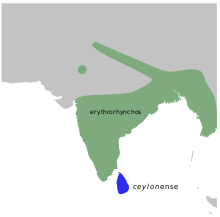Pale-billed Flowerpecker
| Pale-billed Flowerpecker | |
|---|---|
_preening_in_Hyderabad%2C_AP_W_IMG_7326.jpg) | |
| Pale-billed or Tickell's Flowerpecker | |
| Conservation status | |
| Scientific classification | |
| Kingdom: | Animalia |
| Phylum: | Chordata |
| Class: | Aves |
| Order: | Passeriformes |
| Family: | Dicaeidae |
| Genus: | Dicaeum |
| Species: | D. erythrorhynchos |
| Binomial name | |
| Dicaeum erythrorhynchos (Latham, 1790)[2] | |
 | |
Pale-billed Flowerpecker or Tickell's Flowerpecker (Dicaeum erythrorhynchos) is a tiny bird that feeds on nectar and berries, found in India, Bangladesh and Sri Lanka. The bird is common especially in urban gardens with berry bearing trees. They have a rapid chipping call and the pinkish curved beak separates it from other species in the region.[3]
Description
_with_a_Muntingia_calabura_(Singapur_cherry)_fruit_W_IMG_8494.jpg)
This is a tiny bird, 8 cm long, and is one of the smallest birds occurring in most parts of southern India and Sri Lanka. The bird is plain brownish to olive green. The underside is buff olive and does not contrast greatly with the upperparts and not whitish as in the Nilgiri Flowerpecker of the Western Ghats and Nilgiri hills nor is it streaked as in the Thick-billed Flowerpecker. The Nilgiri Flowerpecker has a pale supercilium unlike this species which has no marking on the head. The Sri Lankan race ceylonense Babault, 1920 - is greyer and smaller than the nominate race of peninsular India.[3] It has been considered one of the early flowerpeckers, originating in the Malay Peninsula, to colonize the Indian Subcontinent.[4]
Behaviour and ecology
In forested areas, they often visit the flowers of Loranthus (=Dendrophthoe) and Viscum species, the seeds of which are dispersed mainly by this and other flowerpecker species.[5] The berries of these epiphytic parasites are usually swallowed whole (they sometimes pinch fruits and discard the seeds while feeding on the pulp but this technique is more often used by the syntopic Thick-billed Flowerpecker) and the seeds are voided after a rapid passage through their gut in about three to four minutes.[6] The voided seed has a sticky coating and the bird applies its vent to the surface of a suitable perch and may turn around so as to get rid of the seed, which then sticks onto the branch where it may subsequently germinate.[7][8][9] The flowers of Dendrophthoe falcata are pollinated by this species. The flower has a mechanism that causes pollen to explosively spray on the plumage of the visiting bird.[10][11]
In urban areas, they are particularly attracted to introduced fruit trees such as Muntingia calabura,[12] the fruits of which are swallowed whole. They also feed by crushing ripe berries and sipping the juice. They may also sip nectar from flowers[13] such as those of Sterculia colorata and Woodfordia floribunda, pollinating them in the process.[14][15]
Breeding
These flowerpeckers breed from February to June. A second brood may be raised in September. The nest is a small pendant purse-like structure made of cobwebs, fibre, moss and down suspended from the tip of a twig high up in a tree. The opening is a slit and a clutch of two or three eggs is laid.[16][17]
References
- ↑ BirdLife International (2012). "Dicaeum erythrorhynchos". IUCN Red List of Threatened Species. Version 2013.2. International Union for Conservation of Nature. Retrieved 26 November 2013.
- ↑ Latham, Index Orn., vol. 1 (1790), p. 299 under Certhia erythrorhynchos
- ↑ 3.0 3.1 Rasmussen, PC & JC Anderton (2005). Birds of South Asia: The Ripley Guide. 2. Smithsonian Institution and Lynx Edicions. pp. 544–545.
- ↑ Ripley,S. Dillon (1 June 1949). "Avian Relicts and Double Invasions in Peninsular India and Ceylon.". Evolution 3 (2): 150–159. doi:10.2307/2405549. ISSN 0014-3820. JSTOR 2405549.
- ↑ Ryan GM (1899). "The spread of Loranthus in the South Thana Division, Konkan.". Indian Forester 25: 472–476.
- ↑ Murphy, S. R. , Nick Reid, Zhaogui Yan & W. N. Venables (1993). "Differential Passage Time of Mistletoe Fruits through the Gut of Honeyeaters and Flowerpeckers: Effects on Seedling Establishment." (PDF). Oecologia 93 (2): 171–176. doi:10.1007/BF00317667.
- ↑ Ali. S. A. (1931). "The role of the sunbirds and flowerpeckers in the propagation and distribution of the tree parasite Loranthus longiflorus Desr. in the Konkan (W. India).". J. Bombay Nat. Hist. Soc. 35: 144–149.
- ↑ Ali, S. (1932). "Flower-birds and bird-flowers in India.". J. Bombay Nat. Hist. Soc. 35: 573–605.
- ↑ Davidar, P. (1985). "Ecological Interactions between Mistletoes and their Avian pollinators in South India.". J. Bombay Nat. Hist. Soc. 82 (1): 45–60.
- ↑ Karunaichamy, Kstk; Arp, K. Paliwal and P. A (1999). "Biomass and nutrient dynamics of mistletoe (Dendrophthoe falcata) and neem (Azadirachta indica) seedlings.". Current Science 76 (6): 840–843.
- ↑ Vidal-russell, Romina; Nickrent, Daniel L (2008). "Evolutionary relationships in the showy mistletoe family (Loranthaceae)". Am. J. Bot. 95 (8): 1015–1029. doi:10.3732/ajb.0800085. PMID 21632422.
- ↑ Shyamal, L. (1994). "The Birds of The Indian Institute of Science Campus: Changes in the avifauna". Newsletter for Birdwatchers 34 (1): 7–9.
- ↑ Pittie,Aasheesh (1984). "Tickell's Flowerpecker (Dicaeum erythrorhynchos) sipping nectar from Loranthus (Loranthus longiflorus) flowers - an observation". Mayura 5 (3): 64–65.
- ↑ Solomon Raju, AJ; S Purnachandra Rao, V Ezradanam (2004). "Bird-pollination in Sterculia colorata Roxb. (Sterculiaceae), a rare tree species in the Eastern Ghats of Visakhapatnam and East Godavari Districts of Andhra Pradesh" (PDF). Current Science 87 (1): 28–31.
- ↑ Raju, AJS (2005). "Passerine bird pollination and seed dispersal in Woodfordia floribunda Salisb. (Lythraceae), a common low altitude woody shrub in the Eastern Ghats forests of India" (PDF). Ornithol. Sci. 4 (2): 103–108. doi:10.2326/osj.4.103.
- ↑ Betts, FN (1951). "The Birds of Coorg. Part 2". J. Bombay Nat. Hist. Soc. 50 (2): 224–263.
- ↑ Ali S & S D Ripley (1999). Handbook of the birds of India and Pakistan 10 (2 ed.). Oxford University Press. pp. 12–13. ISBN 0-19-562063-1.
External links
| Wikimedia Commons has media related to Dicaeum erythrorhynchos. |
| Wikispecies has information related to: Dicaeum erythrorhynchos |
